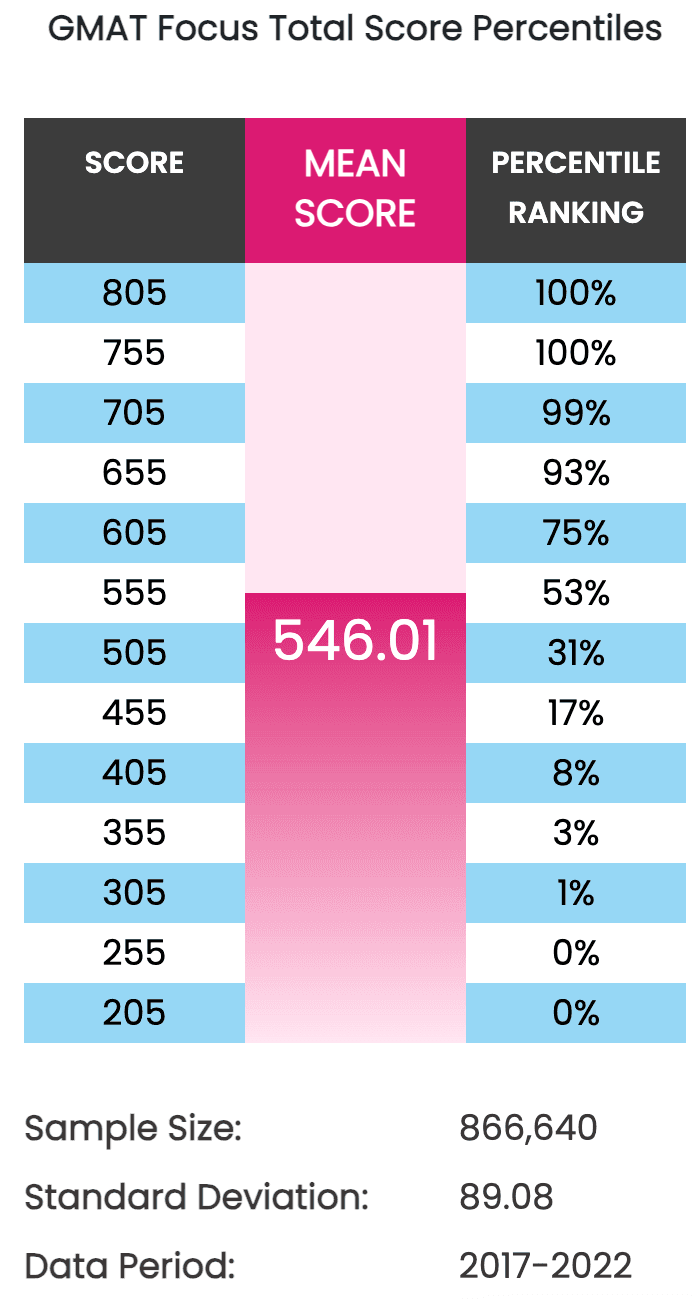
The Graduate Management Admission Test (commonly known as the GMAT) is a high stakes admissions exam for people looking to get into Masters in Business Administration (MBA) programs. Think of it like the SAT or ACT, but for business schools. In the competitive landscape of MBA education, the GMAT Focus Edition is the newest version of this exam and is a standard measure of academic readiness and intellectual aptitude. For those with aspirations in the realms of business or management, this assessment is the primary benchmark that unlocks the doors to top-tier educational institutions. Success in the GMAT Focus is a stamp of readiness for the academic rigors and real-world challenges waiting for you in a rigorous MBA program.
The GMAT and GMAT Focus Edition are the only standardized tests dedicated to business school admissions. You can also take the GRE for MBA admissions, but the GRE is a more general test used in graduate admissions of all kinds.
This article is meant to serve as your guide to navigate the GMAT Focus. Our goal is to equip you with the knowledge and confidence needed to understand and conquer the exam.

The GMAT was designed specifically for MBA admissions. The GMAT was crafted to assess a candidate’s readiness for the rigorous academic demands of MBA programs by evaluating critical thinking, analytical skills, and aptitude for business studies. The GMAT Focus Edition is meant to be an even better assessment of those skills and a candidate’s overall readiness.

The GMAT Focus is a new version of the classic GMAT exam. It will be replacing the standard GMAT as the key exam used for admission to MBA and other graduate management programs starting on January 31st, 2024.
Below is a brief comparison between the standard GMAT and the GMAT Focus.
GMAT | GMAT Focus |
|---|---|
4 Sections: Quantitative Verbal Integrated Reasoning AWA Essay | 3 Sections: Quantitative Verbal Data Insights |
Timing: 3 hours and 30 minutes | Timing: 2 hours and 15 minutes |
Adaptive Sections: Quant and Verbal | Adaptive Sections: All sections |
Scoring: 200-800 | Scoring: 205-805 |
The GMAT Focus’ Data Insights section is most similar to the Integrated Reasoning section on the original GMAT test. However, unlike in the original GMAT, the Data Insights section gets equal weight to the Quantitative and Verbal sections.
As far as subjects to study, the GMAT Focus no longer tests on grammar and geometry. The Integrated Reasoning section has now also been reinvented- with a longer section coined “Data Insights.”
Whereas in the original GMAT exam, test takers have three options on how they can take the exam, in the Focus Edition, test takers are free to choose any section order from all 6 possible combinations.
Verbal – Quantitative – Data Insights
Verbal – Data Insights – Quantitative
Quantitative – Verbal – Data Insights
Quantitative – Data Insights – Verbal
Data Insights – Quantitative – Verbal
Data Insights – Verbal – Quantitative
The GMAT Focus exam has three distinct sections: Quantitative Reasoning, Verbal Reasoning, and Data Insights. These sections assess the pivotal skills crucial for success in graduate management programs.
Quantitative Reasoning:
Quantitative Reasoning tests your math proficiency, problem solving, and data interpretation. From algebra to data analysis, this section assesses your ability to navigate numerical complexities, crucial for managerial decision-making and strategic planning in business.
Verbal Reasoning:
Verbal Reasoning evaluates language proficiency, critical reasoning, and comprehension skills—essentials for effective communication and strategic thinking. It encompasses reading comprehension, critical reasoning, and sentence correction, honing skills vital for thriving in a business environment where articulation and logical reasoning are paramount.
Data Insights:
Data Insights evaluates candidates’ capacity to decipher and synthesize information from diverse sources—charts, graphs, tables—making informed decisions. It’s a real-world simulation of the challenges faced in today’s data-driven business landscape. Mastering this section is crucial as it mirrors the multifaceted decision-making required in modern business scenarios.
Unlike the standard GMAT, the Data Insights section takes the place of the old Integrated Reasoning section. The main difference is that it is an elevated version- with more questions and a higher contribution to the overall score of the exam. This is the primary content difference between the GMAT and GMAT Focus.
Overall:
Each content area on the GMAT exam tests the skills needed for success in graduate management programs. These sections don’t merely test academic knowledge but mirror the multifaceted challenges that you will face in real-world business scenarios.
Unlike the standard GMAT that took approximately 3 hours and 30 minutes to complete, the GMAT Focus is 2 hours and 15 minutes with one optional 10-minute break.
GMAT Focus Structure
Section | Format | Timing | Subjects |
|---|---|---|---|
Quantitative | 21 multiple–choice questions | 45 minutes | Arithmetic, algebra and basic geometry |
Verbal | 23 multiple-choice questions | 45 minutes | Logic skills, and short and long passage comprehension |
Data Insights | 20 multiple-choice questions | 45 minutes | Data presented in various charts, graphs, and tables, testing quant, verbal, and analytical skills |
The price of the GMAT will vary a little based on your location, but is generally around $300.
In the United States, the online version of the GMAT costs $300 USD, while the testing-center version costs $275 USD. These prices include the option to send score reports to up to five programs of your choice.
For other countries, you can look up the pricing in your country on the official GMAT website.
The difficulty of the GMAT Focus can vary for different people based on their strengths, preparation, and familiarity with the test format. For some, it might be challenging due to its time constraints, adaptive nature, and the range of skills it evaluates.
Annually, over 200,000 individuals take the standard GMAT. The GMAT Focus was released this year, but the projections for how many people will be taking the exam are similar. The exam itself is challenging, and with so many other candidates taking the exam each year, it’s very important to prepare in order to score well enough to be competitive in top business programs.
It’s recommended to prepare thoroughly, understand the question types, and practice time management to improve your chances of success.
The GMAT Focus is not structured like a typical exam, and its complexity extends even beyond an exam like the GRE. The GMAT’s questions measure your ability to think critically and apply reason to solve complex problems, utilizing logic problems and complex concepts as the context for each question. This means that you cannot just prepare your basic math and verbal skills, but also train in deciphering complicated statements and pulling out necessary information needed to understand the questions at hand. The MBA website has prep materials for practicing before you take your exam.
It is also crucial to take practice exams and complete as many practice problems as possible. One major barrier for many people taking the exam is that it is a very long exam, but you will only have about 2 minutes on average to complete each question. This creates a stressful environment that will create burnout quickly if you have not trained the necessary endurance. Luckily, you can train yourself in this regard, just as you would train physical endurance. Preparation is key!
Finally, one factor that can often contribute to exam-day stress is the testing environment. You have the option to take the test at either an approved testing center or online from your home. There are slight differences to which option you choose, but the test itself will be identical. Either option comes with its own pros and cons.
Ultimately, the GMAT Focus exam is set up to be difficult, long, and uncomfortable. Setting yourself up for success is the best thing you can do to stay ahead of the exam creators and make the test your own.

The GMAT Focus is scored from 205 to 805 in 10 point increments, with 205 being the lowest score and 805 being the highest score. Your total GMAT Focus score is based on your raw scores from all three sections.
The way that the GMAT Focus calculates this score is similar to other standardized tests. First, you will have a ‘raw score’ for each section, which is the number of questions you got right or wrong out of the total. This is weighted by the difficulty of each question – especially important for the GMAT because the test adapts its difficulty as you go – and then measured against the full body of test takers to give you your ‘scaled score’. This is the 205-805 score that you see.
GMAT Focus Score Chart
Section | Scoring Range | Scoring Intervals |
|---|---|---|
Quantitative | 60-90 | Intervals of 1 |
Verbal | 60-90 | Intervals of 1 |
Data Insights | 60-90 | Intervals of 1 |
Total | 205 - 805 | Scores are reported in intervals of 10 |
On a national level, the best way to think about your score is to compare it to test takers nationwide through what is called ‘percentiles’. A percentile means “what % of test takers does this score beat?” For instance, if you have a percentile ranking of 80%, it means that you scored higher than 80% of the other test takers, and 20% of them scored higher than you.
Below is a chart provided by the official site:


To effectively prepare for the GMAT Focus, you will need to review all of the content covered in the test, take ample practice questions and practice exams, and make sure to re-review what you’re getting wrong. Beyond that, the other crucial element is time management. Creating a study timeline tailored to your needs is key. While the ideal duration varies for each individual, experts recommend dedicating a minimum of 3-6 months for thorough preparation. In terms of actual time, we recommend you plan to spend at least 100 hours studying, which is 8 hours per week over 3 months or 4 hours per week over 6 months.
Be sure to craft a study plan that balances consistent learning with practice tests closer to the exam date. While there is no one way to study for the exam, below is an example 12 week timeline of a standard study approach:
In addition to the schedule above, we have a few tips to help you:
We hope this helps you effectively prepare for the GMAT Focus!

Once you’ve decided to take the GMAT, start by making an account on MBA.com – the official GMAT website.
The GMAT Focus test dates are available throughout the year, giving you the flexibility to choose a slot that aligns with your study schedule and application deadlines. It’s crucial to plan ahead, as the most popular test centers can book out during peak periods.
When registering for the GMAT, make sure your name exactly matches your GMAT registration. Otherwise you will not be permitted to take the test on test day.
You can take the GMAT Focus at a test center or online from home. Wherever you choose to take the exam, the format and questions are identical. The only difference is that the in-center version allows you to print out an Enhanced Score Report, and the at-home version will have additional requirements around your webcam and room to ensure that you’re not cheating. See the GMAT website for more information about the at-home online test requirements.
Plan to arrive at the test center at least 30 minutes prior to your exam start time. There will be a check-in process, and some centers will have other exams starting at the same time, so lines may take some time. You also do not want to be rushing as that can increase your anxiety and put you in a bad mental spot right as you’re about to take the test.
Bring a valid photo ID that complies with your local ID requirements. This will be your pass in and out of the testing room.
You will have the opportunity to select up to five schools to send your scores to for free before taking the exam, so be ready with schools you plan to apply to. After this period, or if you want to send your score to more programs, you can send additional score reports for a fee.

Once you complete your exam, you will be able to view your estimated scores. These are your GMAT Focus unofficial scores and you will have two minutes to accept or cancel your exam. If you choose to keep your scores, your official GMAT Focus score will be available to you within 20 days from the date of the exam.
If you accept your unofficial scores on the test date, GMAC will send your official scores to the universities you chose on that test date. Canceled GMAT scores do not appear on the score report and the GMAC will not send it to your chosen universities.
You will have up to five years to send your scores to any additional schools for a fee (currently $35). This can be done via the GMAT website.
The GMAT can be taken no more than five times in a year. That means five attempts in 12 rolling months. In addition to this restriction, students can only take the GMAT a total of eight times in a lifetime.
GMAT scores are valid for up to five years after you take the exam and choose to keep your scores. This means that you can send your GMAT scores to business schools for up to five years from the date you took the test.
Taking on the GMAT Focus isn’t just about scoring well on a test; it’s about paving your road into business schools and setting the foundation for a successful career in business and management. From explaining the test content and understanding scoring and percentile rankings to steps on how to sign up, hopefully this guide has demystified the GMAT Focus and helped you prepare for the exam.

In order to apply for your Master of Business Administration (MBA), you’ll need to submit either a Graduate Management Admission Test (GMAT) or Graduate Record Examination (GRE) score. To complicate your choice between the two, both the GMAT and the GRE have come out with new versions of their respective MBA admissions exams in the …

The Graduate Management Admission Test (commonly known as the GMAT) is a high stakes admissions exam for people looking to get into Masters in Business Administration (MBA) programs. Think of it like the SAT or ACT, but for business graduate schools. In the competitive landscape of MBA education, the GMAT is the standard measure of …